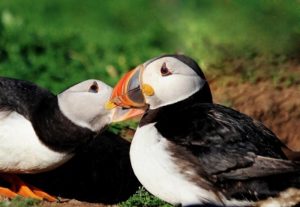
A new study carried out by researchers from Oxford University and the London Institute of Zoology suggests that puffin pairs that follow similar migration patterns tend to birth more chicks than those who follow disparate flight plans.
Puffins migrate to far-away wintering grounds during the non-breeding season, and very little information is available about their mating patterns, behavior or bonding between pairs.
In this study, geolocators were used by the researchers to keep track of the movements of 12 pairs of Atlantic puffins. The results revealed that mates don’t share similar flight patterns, but do follow similar paths during the start and end of their winter migration, and this proximity was found to be important for their reproductive success.
Pairs following similar paths were found to give birth to more chicks after their return to mating grounds in the spring. Other factors were also found to be important in reproductive success.
“While migrating close to one’s partner leads to more successful breeding in puffins, female winter foraging effort seems to be even more critical to ensure high reproductive success,” Annette Fayet, a junior research fellow at Queen’s College, said.
“A likely explanation for this finding is that female puffins which spend more time fueling up over winter return to the colony in better condition and are able to lay higher quality eggs, rearing stronger chicks.”
“Overall it seems that prioritising individual condition is more important for seabirds’ breeding success than maintaining contact with their partner outside of the breeding season. However, following similar migration routes to one another may help synchronise returns to the breeding colony, which is known to be important for pair bond and breeding success in many migratory birds.”
Presently, scientists know very little about the time spent by puffins at sea.
“At the end of the breeding season puffins disappear at sea for over eight months before returning the following spring, and scientists have long had questions about where they go during that time. However, until recently tracking devices were too big to use on small birds like puffins.”
“The recent miniaturisation of tracking technology mean we can now study the at-sea movements of puffins and other small migratory seabirds remotely over months and even years. Complex analytical techniques like machine learning can also be used to identify behaviours in tracking data, allowing us to know not only where birds go, but also what they do at sea (e.g. flying, foraging). This will help us study seabirds’ at-sea ecology and behaviour, which is currently poorly understood, but the results will also be invaluable for the conservation of seabirds, which are currently threatened by ocean pollution and overfishing, making them the most endangered group of birds on the planet. This includes puffins, which have been dramatically declining in the last few decades.”
The detailed findings of the study have been published in the journal Marine Ecology Progress Series.
